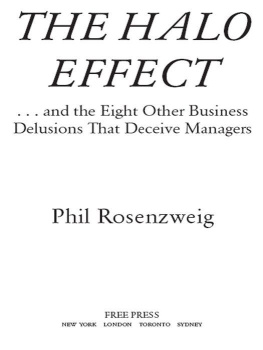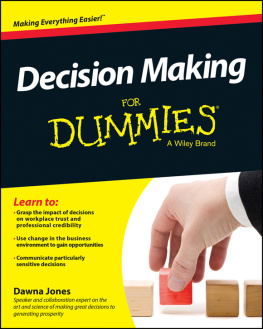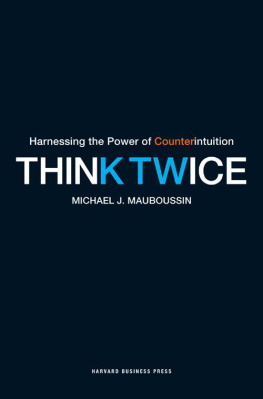

Copyright 2014 by Phil Rosenzweig.
Published in the United States by PublicAffairs, a Member of the Perseus Books Group.
All rights reserved.
No part of this book may be reproduced in any manner whatsoever without written permission except in the case of brief quotations embodied in critical articles and reviews. For information, address PublicAffairs, 250 West 57th Street, 15th Floor, New York, NY 10107.
PublicAffairs books are available at special discounts for bulk purchases in the U.S. by corporations, institutions, and other organizations. For more information, please contact the Special Markets Department at the Perseus Books Group, 2300 Chestnut Street, Suite 200, Philadelphia, PA 19103, call (800) 810-4145, ext. 5000, or e-mail .
Book Design by Pauline Brown
Typeset in Goudy Old Style Std by the Perseus Books Group
Library of Congress Cataloging-in-Publication Data
Rosenzweig, Philip M., 1955
Left brain, right stuff : how leaders make winning decisions / Phil Rosenzweig.First edition.
pages cm
Includes bibliographical references and index.
ISBN 978-1-61039-308-9 (e-book)
1. Decision making. 2. Decision makingPsychological aspects. 3. LeadershipPsychological aspects. I. Title.
HD30.23.R6725 2013
658.4'03dc23
2013031990
First Edition
10 9 8 7 6 5 4 3 2 1
For the home team
Laura, Tom, and Caroline
CONTENTS
COMPARED WITH MANAGING, TRADING WAS ADMIRABLY DIRECT. YOU MADE YOUR BETS AND EITHER YOU WON OR YOU LOST.
MICHAEL LEWIS, LIARS POKER, 1989
It was a billion-dollar decision, give or take a few million.
On the night of August 12, 2010, Bill Flemming, president of Skanska USA Building, faced a tough choice. Get it right, and the upside could be very lucrative. Get it wrong, and the results could be disastrous.
The story began a year earlier, when the National Security Agency (NSA) announced plans to build a computer facility for the security information it gathers around the world. The Utah Data Center (UDC) would be fully self-contained, with its own power plant and water supply, and would come equipped with antiterrorism defenses. The site for this sprawling complex was the abandoned airfield at Camp Williams, a National Guard base in a lonesome canyon south of Salt Lake City. A forbidding location, but ideal for this purpose. It was vast, remote, and very secure.
Skanska USA Building was a division of the Swedish-based company, Skanska, and a leader in the North American construction industry. It had a strong record of large and successful projects. The company had recently completed the MetLife Stadium in New Jersey, home of the football Giants and Jets, a state-of-the-art marvel that could hold eighty-two thousand fans. It was currently at work on dozens of projects, from the renovation of the United Nations building on Manhattans East Side to the World Trade Center Transportation Hub, the network of train and subway stations under Ground Zero.
The UDC was doubly attractive to Flemming. It was a design/build project, meaning that the contractor handled both design and construction. Flemming explained: If you can come in with a better designmore efficient and smarter functionalityand if you have methods to build the facility faster, then you might beat the other bidders.
But Skanska wouldnt be bidding alone. Several other top construction companies were just as eager to win the deal.
The first step was to answer the NSAs Request for Qualifications, which asked for a list of relevant experience and resources. Skanska USA Building, working with a partner, Okland Construction Company, was one of twelve bidders to submit an RFQ in February 2010. Two months later, the NSA eliminated seven and invited just fiveSkanska and four othersto submit formal bids. They were given sixty days.
Over the next weeks, Flemming and his top aides worked with a team of subcontractors to prepare the bid. The NSA was explicit about the layout and capacity it wanted and also defined the technical standards. Although no price was stated, it was rumored that Congress had appropriated more than $1 billion. For prospective bidders the message was clear: it was more important to provide the best performance than to meet a specific price.
On June 16 Skanska USA Building submitted a bid for the Utah Data Center with a price tag of $1.475 billion. And then it waited.
In early July the NSA issued its reply. All five bids had come in between $1.4 billion and $1.8 billion, substantially more than the government wanted to spend. Now the NSA narrowed the scope of the project, keeping the key elements but eliminating a few redundancies. Technical performance was just as important, and the schedule was unchanged. For the first time the NSA specified a target price: $1.212 billion. Now price was a crucial element. A bid in excess of that amount would be rejected for noncompliance.
The same five companies were invited to submit new bids, with Best and Final Offers due on August 13, just six weeks away.
Now it was game on. At Skanska USA Buildings head offices in Parsippany, New Jersey, a large conference room was dedicated to the UDC bid. Only approved personnel were allowed inside, their access limited by swipe cards. A team of twenty-five pored over every aspect of the project, looking for ways to lower the cost. Removing some redundancies helped, but there was still a long way to go. Everyone was focused on a single goal: how to get to one-point-two-one-two.
For the next six weeks, during the hottest summer on record, Flemmings team looked for ways to drive down costs.what they would earn. By committing to working more quickly and efficiently, they were able to lower the bid still further.
By early August Skanska USA Buildings bid stood at $1.26 billion, now tantalizingly close to the target of $1.212 billion. Could Skanska take out even more and eliminate that $48 million gap, producing a bid that was low enough to win but high enough to earn a profit? Or would going lower expose Skanska to serious losses?
As he pondered the way forward, Flemming considered several factors. The UDC would take three years to build, during which time it should be possible to find additional savings. The question was how much. Skanska had reason to be optimistic. In an industry known for cost overruns, Skanska USA Building had often done better than budget. It had won the MetLife Stadium contract with a bid of $998 million, well below its nearest rival, and still found a way to earn greater profits than expected. The World Trade Center Transportation Hub was currently running ahead of schedule and also below cost. Surely further savings would be possible for the UDC as well. Flemming commented: The experience that Ive had over the years is typically, you can get someplace between another 3 percent and 4 percent out. Taking out 3 percent would bring Skanska from $1.26 billion to $1.222 billion, still short of the goal. Reaching $1.212 billion would require lowering the bid by 3.8 percent, which was very ambitious but not impossible.
Next page









